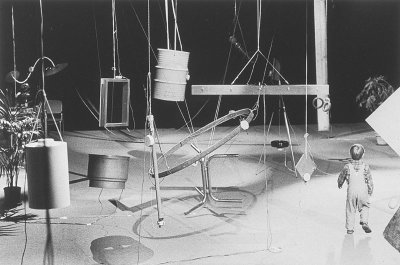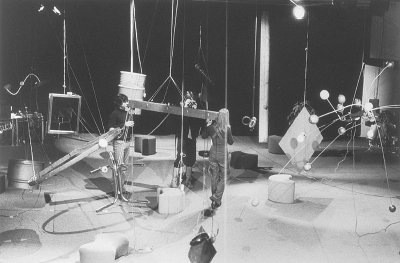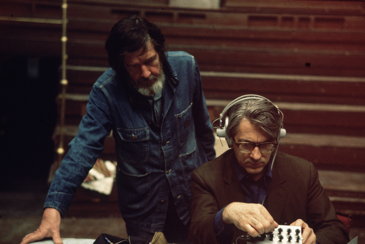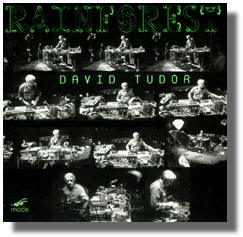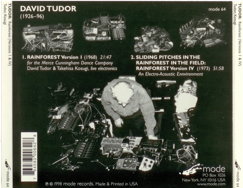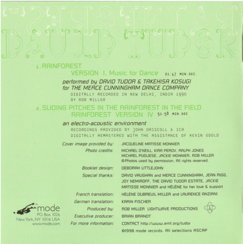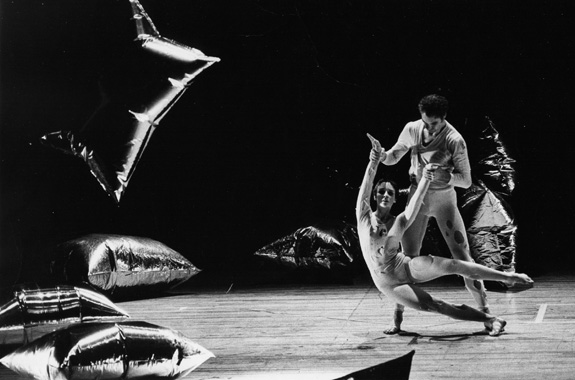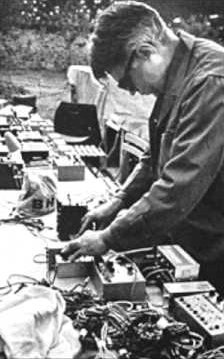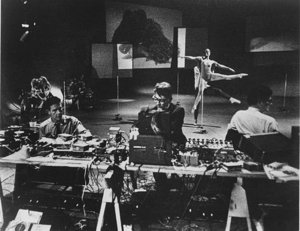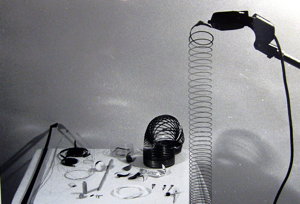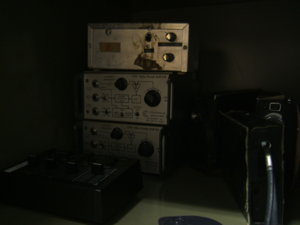Research Studies/Études & Recherche : — [Studies - Environmental Music / Études Œuvres Environnementales]— [Research] — PENDULUM
RAINFOREST (DAVID TUDOR)première partie / Part 1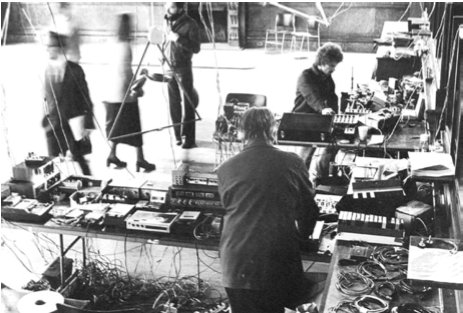
|
Articles connexes / Other related articles:
- NOISE - 1 - BANDONEON (David Tudor) — read / lire
- WORKS (David Tudor) — bientôt / soon
- PAVILION (EAT) — bientôt / soon
- CONSPIRACY 8 (Gordon Mumma) — bientôt / soon
- UNTITLED EVENT (John Cage) — bientôt / soon
- MUSICIRCUS (John Cage) — bientôt / soon
— Part 1 — Introduction — L'Œuvre Rainforest — Les Versions de Rainforest — La Référence à la forêt — Les Réalisations Rainforest
— Part2 — La Partition Rainforest — Le Dispositif-Circuit — Les Résonateurs — Le Déroulement d'une performance Rainforest — La Participation des Auditeurs et la Place de l'Écoute — Les Enjeux Musicaux de Rainforest — Références'
— Part 3 — Rainforest IV par NoEnsemble
Introduction(Edit)
La difficulté du montage d'une interprétation de Rainforest (1968-1973) de David Tudor (1926-1996) réside dans plusieurs aspects :
- la "partition" consiste en un schéma d'un circuit électronique qu'il s'agit d'appliquer et de mettre en action (par chaque performeur de l'œuvre) ; ce schéma donne lieu à une examen interprétatif pour sa mise en œuvre (input ou source sonore / filtres / transducteur / objet résonant / microphone de contact /, etc.) et pour construire la série de chaînes électro-acoustiques qu'il s'agira d'agencer dans l'espace,
- une série de versions se sont succédées de 1968 à 1973 au fur et à mesure des explorations de David Tudor autour des principes qu'il avait mis en place pour cette œuvre ; et même dans la version IV (1973) qui correspond au circuit "généralisé" de cette œuvre, il est à remarquer que Tudor continuera à adapter, à interpréter et à faire varier et moduler les éléments nécessaires à la réalisation de Rainforest,
- il n'existe aucun texte descriptif ou théorique rédigé par Tudor ; ainsi les seules indications sur lesquelles nous pouvons nous appuyer pour examiner les différentes expériences de cette œuvre et pour discerner les éléments "structurels" récurrents de Rainforest, sont l'accès aux interviews successifs qu'il a pu donner.
Il en résulte, qu'à la différence d'autres œuvres musicales dont la partition est le support véritable de leur restitution et de leur interprétation, Rainforest ne peut être abordée qu'en la réalisant et qu'en mettant à l'épreuve son interprétation dans l'expérience d'une réalisation, puisqu'en fin de compte aucun modèle (enregistrement) n'est reproductible. Comme il s'agit d'une œuvre "collective" à réaliser par un ensemble d'interprètes et qui prend toutes ses potentialités de variabilité, à la fois, dans la singularité (des objets/instruments choisis par les performeurs), dans la durée (un temps long d'exécution), et dans l'attention individuelle de chaque auditeur, chacune de ses interprétations se présente comme une véritable création.
La particularité de Rainforest de David Tudor est d’être à la fois
- un système (modélisé et généralisé par le schéma et le diagramme d'un circuit électronique, sans annotations de consignes)[1]
- une installation (comprenant la distribution spatiale d'objets et donc une occupation visuelle de cet espace) de nature "environnementale" (selon David Tudor[2]),
- une performance et un concert durant lequel le public est actif en circulant dans l’espace pour moduler son écoute (Rainforest IV),
- un environnement collaboratif regroupant performeurs et auditeurs.
Rainforest regroupe un ensemble indéterminé de musiciens performeurs qui improvisent, durant un temps non circonscrit, sur le système (très souvent appelé « éco-système ») fabriqué par eux-mêmes à partir de matériaux résonants excités par des circuits électroniques, des capteurs et des haut-parleurs spécifiques (transducers, vibreurs).
Ce dispositif instrumental devient œuvre,
- composée de circuits de résonateurs et de transducteurs (excités et captés par les jeux des performeurs),
- conditionnée en direct par le caractère du lieu et de ses résonances (indiquant ainsi une prégnance de l'œuvre dans l'espace et le temps qu'elle occupe),
- et, finalement, sans point focal ni linéarité, du fait de la distribution des sources et des provenances sonores, ainsi que de la durée de l'événement (sur plusieurs heures, sur plusieurs jours).
Les sons proviennent des caractéristiques de résonance des objets/haut-parleurs utilisés et de leurs sources électroniques ou analogiques qui les excitent.
Une autre caractéristique importante de cette œuvre est son instabilité et sa variabilité : chaque interprétation et réalisation donne lieu à de nouvelles expériences, non seulement bien entendu pour les auditeurs, mais aussi pour les performeurs. La variété des objets résonants utilisés et le fait d'utiliser à chaque fois des objets différents (selon les lieux de la performance) demande de tester, de régler et d'ajuster les dispositifs/circuits sonores, et, en fait, de découvrir tout au long de la performance les capacités acoustiques de ces objets, de leurs possibilités et de leurs limites, ainsi que leur potentiel d' "interaction" sonore acoustique entre eux dans l'espace.
| Je trouve d'ailleurs que c'est une œuvre basée pratiquement sur des formes "d'apprentissage", voire d'auto-apprentissage, du fait que chacun découvre comment il doit programmer et développer son dispositif en fonction de ce que celui-ci peut "encaisser" [3]. — David Tudor, from An Interview with David Tudor by Teddy Hultberg in Dusseldorf, May 17-18, 1988, http://davidtudor.org/Articles/hultberg.html |
Par ailleurs le dispositif lui-même joue de l'instabilité : les réglages d'intensité des sons envoyés dans les vibreurs ainsi que leur captation par les microphones de contact (piézoélectriques), tout en étant basés sur la transmission et la vibration de matières, sont difficiles à contrôler, et un mouvement de réglage très fin peut très bien moduler le son sur une ampleur inattendue et ainsi créer des reliefs sonores (de mixages acoustiques dans l'espace) tout-à-fait étonnants pour les auditeurs qui déambulent dans l'espace. Dans ce sens, David Tudor a créé un univers sonore en perpétuel mouvement et imprévisible, en état d'équilibre à la fois abstrait et évocateur.
Dans le prolongement de cette réflexion, il faut noter que David Tudor, comme Cage, pense que la technologie électronique possède en elle-même une force égalitaire et démocratisante permettant "à la personne ordinaire [de] devenir musicienne — et à chaque individu, son propre musicien. Cela doit arriver [...] et l’électronique est une manière d’y parvenir."[4].
De même, le musicien se met à explorer et à mettre en pratique, en tant que compositeur, ce qu'il "perçoit" en tant qu'interprète, en tant qu'auditeur, mais aussi en tant que "fabricant" de ses instruments :
| David Tudor et Gordon Mumma ont effectivement combiné les rôles de musicien et d'ingénieur en construisant et en jouant sur leurs propres instruments électroniques [5] . — (David Neubert, "Electronic Bowed String Works: Some Observations on Trends and Developments in the Instrumental/Electronic Medium", In Perspectives of New Music, Vol. 21, No. 1/2 (Autumn, 1982 - Summer, 1983), pp. 540-566) |
Il s’intéressait à « l’écologie médiatique complexe » issue de la rétroaction entre les médias. Dans des notes écrites quelques années plus tard (en 1973), Tudor explique : « Le traitement et la programmation sonores, de même que tous les logiciels, devaient contribuer à cette tendance (imprévisible) vers l’oscillation — y compris la multiplication des circuits. »[6]. Cette « tendance imprévisible » suggère le concept d’« émergence », si déterminant pour les œuvres d’art autogénératrices et les développements à venir concernant la vie artificielle(et la cybernétique). Il pointe ici la création d'événements imprévus et non programmables (ou issus d'une "sur-programmation" ou d'outputs imprévus gérés par la programmation) générés par le fonctionnement du système même.
| Je trouve que les signaux d'entrée les plus simples créent des résultats sonores les plus complexes. Si vous prenez un résultat très complexe, il peut devenir très prévisible, mais si vous prenez quelque chose d'assez simple, ce qui en sort devient étonnant. C'est comme une révélation en quelque sorte. Afin de faire de tels générateurs, j'ai testé des amplificateurs en boucle pour obtenir des feedback sonores imprévisibles. L'étape suivante est pour moi assez évidente, car en fait tout cela m'amène à générer du son sans utiliser de source sonore [(externe)]. Plutôt que d'utiliser des générateurs de son ou des sons enregistrés et des prises de son, j'ai expérimenté avec les principes de l'amplification, en essayant de faire osciller des amplificateurs d'une manière absolument imprévisible. En fin de compte, il s'est avéré que je n'ai même pas eu besoin d'amplificateurs parce que la plupart des équipements électroniques utilise le principe de l'amplification. Vous avez besoin simplement de filtres, de modulateurs et de tables de mixage qui ont un potentiomètre réglable de gain. En empilant et en combinant ces composants et ces éléments, j'étais capable de travailler sans aucun générateur de sons et j'ai réalisé plusieurs œuvres de cette façon. L'une d'elles était "Toneburst" qui a également été réalisé pour Merce Cunningham.[7]. — David Tudor, from An Interview with David Tudor by Teddy Hultberg in Dusseldorf, May 17-18, 1988, http://davidtudor.org/Articles/hultberg.html |
| DT (David Tudor) : [...] Quand le son semble être produit en direct dans un espace, alors il est "libre" [et vivant], il semble s'écouler, se propager et fluctuer par lui-même et de ne pas être la cause d'une intention spécifique, en particulier de nature intellectuelle. Si vous vous mettez dans une situation d'imprévisibilité et que vous trouvez que c'est tout à fait possible de l'accepter, alors vous devenez un observateur. Alors vous voyez que le son peut être "libre". Je sais c'est dur d'être clair sur cette notion, parce qu'un son est quelque chose que l'on reçoit, mais si vous mettez plusieurs sons ensemble, ils créent un contexte et si cela est grevé par une intention de conquérir ou d'une intention d'impressionner, alors ... eh bien, si je me trouve dans cette situation, je suis plutôt malheureux. Je souris quand les sons modulent et "chantent" dans un espace. —TH (Teddy Hultberg) : Pensez-vous que cette manière de "libérer" les sons a des impacts sociaux et indiquent un engagement social ? — DT : Oui, j'espère bien, mais vous m'entendrez jamais parler de cela. — TH : pourquoi pas ? — DT : Parce que je ne suis pas ce genre de compositeur.[8]. — David Tudor, from An Interview with David Tudor by Teddy Hultberg in Dusseldorf, May 17-18, 1988, http://davidtudor.org/Articles/hultberg.html |
L'Œuvre Rainforest(Edit)
L'intention initiale de David Tudor se base sur le rejet de l'artificialité dont il remarque la présence constante dans la production et la représentation (voire l'exécution) des musiques "pré-conçues". Sa remarque porte notamment sur l'utilisation des haut-parleurs qu'il voudrait utiliser en tant qu'instrument et non pas comme un appareil capable de restituer tous les sons qu'on lui attribue. Un haut-parleur ne serait plus seulement un appareil de reproduction du son mais un instrument en lui-même.
| Rainforest IV est issu de réflexions que j'ai développées à partir de 1965. Le concept de base était fondé sur une préoccupation technique : l'idée que le haut-parleur devrait avoir une propriété (ou une "voix") singulière et unique et ne pas être un simple appareil de reproduction mais un instrument à part entière. Une opportunité s'est présentée lorsque j'ai été sollicité pour faire une proposition artistique pour un parc à Washington (ce projet n'a pas abouti). La proposition était de réaliser une sculpture sonore en plein air ; à partir de là je me suis mis à réfléchir. Et j'ai pensé qu'il serait vraiment magnifique si chaque sculpture pouvait "sonner" de manière différente l'une de l'autre et si l'ensemble pouvait fonctionner et être géré à partir d'une seule machine qui agirait ainsi comme un commutateur [pouvant gérer par exemple un assemblage de plusieurs interrupteurs permettant des choix multiples]."[9] — (David Tudor, from An Interview with David Tudor by Teddy Hultberg in Dusseldorf, May 17-18, 1988, http://davidtudor.org/Articles/hultberg.html ) |
Acteur de la musique électronique vivante (live electronic music), il parle ainsi de mettre en place un système "naturel" qui anime ce qui est présent dans un espace, ce dernier en retour réagissant comme un environnement résonant dans lequel les auditeurs créent des reliefs d'écoute selon leurs déplacements et leurs positionnements.
| Rainforest est une œuvre dans laquelle l'aspect visuel est partie prenante de la conception. Vous prenez un espace et vous concevez la façon dont les objets vont être distribués dans cet espace, et la façon dont le son va l'imprégner. Donc tout ceci est une question de conception [10]. — Tudor, David. Interview with Bruce Duffie. Chicago, April 7, 1986. Recording obtained from the interviewer, and transcribed by Matt Rogalsky. http://www.bruceduffie.com/tudor3.html |
Ce système comprend des objets qui habitent cet espace (d'où une préconisation d'utiliser les éléments déjà présents, voire délaissés (junk) dans l'espace choisi) et qui deviennent des résonateurs (en fait de nouveaux "haut-parleurs"). Il comprend également des circuits électroniques sonores connectant les objets résonants aux traitements sonores électroniques conçus par les performeurs. Ces circuits (ou boucles d'injections et de rétroactions sonores (feedback)[11] sont indépendants les uns des autres mais peuvent être reliés entre eux (par une matrice) pour provoquer des interactions continuelles entre les processus de jeux mis en place. Ces boucles d'injections traitant au passage le son qui les traversent relient les inputs et les outputs par l'intermédiaire de l'objet résonant qui se trouve ainsi excité.
| en cours de transcription — En fait il y a quelque chose qui est très présent dans mon travail depuis que j'ai découvert des processus naturels [ou quand découvert que l'instrument peut être un objet naturel]. C'est de cette réflexion que vient mon projet "Rainforest". Parce que je sentais depuis plusieurs années qu'en fait un haut-parleur est une obscénité et un faux concept, un concept qui n'a pas de réalité. Il a été créé pour reproduire les sons. Pour moi un haut-parleur c'est une membrane vibrante et et il est capable de ce fait de créer par lui-même des sons par vibrations. Et donc j'ai rêvé un jour qu'il serait pas mal d'avoir une "forêt" ou un orchestre de haut-parleurs chacun d'entre eux ayant un son différent. Ce qui signifie que ils devraient avoir le son qu'ils ont par eux-mêmes, plutôt que de simplement reproduire d'autres sons, [des sons préconçus] qui proviennent de la représentation qu'en a quelqu'un. Même si un haut-parleur ne reproduit qu'une seule fréquence sonore, cela reste un instrument. C'est en quelque sorte pour moi un processus naturel, ces instruments n'ont pas besoin d'une musique "pré-conçue". Je me suis retrouvé dans la situation de créer une pièce électronique avec des sources sonores totalement non sophistiquées. (à suivre) (Extrait d'un Interview de John Cage & David Tudor, le 29 mai 1972) |
|
ÉCOUTER UN EXTRAIT DE L'INTERVIEW DE JOHN CAGE & DAVID TUDOR (29 MAI 1972) — source : http://archive.org/details/AM_1972_05_29 |
Les versions de Rainforest(Edit)
Première version, Rainforest I (1968)(Edit)
| La première version de Rainforest est une partition sonore pour une chorégraphie éponyme de Merce Cunningham. Elle consistait en des transformations sonores sans l'utilisation de modulations et de traitements électroniques : les sources sonores transmises aux objets étaient modifiées par les résonances propres de ces matériaux. [...] Dans cette première version j'ai utilisé des objets que je pouvais transporter avec moi. Les objets étaient de si faibles dimension et envergure qu'ils n'avaient aucune présence sonore dans l'espace. J'ai donc décidé de les amplifier en utilisant des microphones de contact. [12] — (David Tudor interviewé par John Fullemann 10/12/85) |
| J'ai finalement acquis des dispositifs appelés transducteurs audio [(en quelque sorte un haut-parleur sans membrane, ou vibreur, qui permet de propager le son au contact d'un autre matériau)]. Ils ont été développés tout d'abord pour l'US Navy parce qu'ils avaient besoin d'un système sonore qui pouvait être utilisé dans n'importe quel type de situation même sous l'eau. Je suis allé voir le fabricant et il m'a donné plusieurs exemplaires de ce système. Par la suite ils l'ont commercialisé. J'en avais donc quelques-uns lorsque Merce Cunningham m'a demandé en 1968 de réaliser une pièce musicale pour une de ses chorégraphies, et j'ai décidé de réaliser de manière expérimentale une sculpture sonore de très petite dimension. J'ai pris ces transducteurs et je les ai apposés et attachés sur des petits objets, et ainsi j'ai programmé un système en utilisant des sons à l'aide de générateurs sonores. Les sons produits au travers des objets étaient captés par des cellules de lecture d'électrophones (diamants) et envoyés et diffusés sur un système de sonorisation de haut-parleurs.[13] — David Tudor interviewé par Teddy Hultberg à Düsseldorf les 17 et 18 mai 1988, http://davidtudor.org/Articles/hultberg.html |
| [...] Merce Cunningham m'a demandé de réaliser une œuvre [pour sa chorégraphie Rainforest]. Bien, j'avais ces systèmes [les transducteurs qui l'avaient utilisé en 1966 pour Bandoneon pour réaliser des "haut-parleurs instruments" lors des 9 Evenings à New York[14] [15]] qui traînaient, donc je pourrais tout aussi bien les mettre à profit. Donc la première chose que je fis a été de travailler avec un amplificateur pour les faire fonctionner. J'ai construit un amplificateur à huit canaux à faible capacité. Et j'ai fabriquer des objets avec lesquels je pouvais facilement voyager et transporter. Et ils étaient si petits qu'ils n'avaient aucune présence sonore dans l'espace, alors j'ai ensuite amplifié les sorties en utilisant des microphones de contact. [16]. |
|
ÉCOUTER UN EXTRAIT DE RAINFOREST I (1968) — Version pour Cunningham, New Delhi, 1990, David Tudor & Takehisa Kosugi, live electronics (CD Mode Label http://www.moderecords.com/catalog/064tudor.html ) |
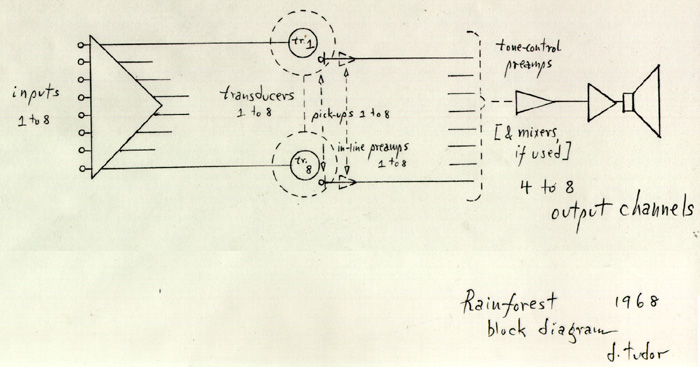 | PARTITION/DIAGRAMME DE RAINFOREST I, DAVID TUDOR, 1968 |
Au début de 1968, Merce Cunningham crée une nouvelle chorégraphie dont l'inspiration provenait des recherches de l'anthropologue britannique Colin Turnbull dont l'un de ses livres, "Le Peuple de la Forêt" était consacré aux Mbutis, peuple pygmée de la forêt d'Ituri au Zaïre. Pour la musique, Cunningham s'est tourné vers Tudor et pour la première fois lui a demandé une œuvre originale. Quand ce dernier a appris que la danse devait s'appeler "Rainforest" (forêt tropicale), Tudor a dit, "oh, je vais y mettre beaucoup de gouttes de pluie". Les gouttes de pluie n'étaient en fait qu'un début : en utilisant des transducteurs audio conçus à l'origine pour la marine américaine pour l'audition simultanée sous et au-dessus de l'eau, et apposés sur une série de huit petits objets excités par des signaux provenant de générateurs de sons, ainsi que des capteurs microphoniques de contact conçus à partir de cellules de lecture de microsillons et relayant le son capté vers deux ensembles de haut-parleurs, Tudor a créé un univers sonore en perpétuel mouvement et imprévisible, en état d'équilibre à la fois abstrait et évocateur.
La création de cette œuvre eut lieu le 9 mars 1968 et était performée par David Tudor et Gordon Mumma lors de la représentation de la chorégraphie de Cunningham lors du second Buffalo Festival of the Arts Today au State University College[17].
Quelques mois plus tard en mars 1969 et libéré du cadre temporel de la chorégraphie, Rainforest fût donné en tant que concert/performance dans un grand auditorium à l'université Cornell à Ithaca (NY) et joué par David Tudor et Gordon Mumma sur une durée de 42 minutes. L'équipement électronique sonore a été mis sur des tables du centre de l'espace, avec le public assis autour des artistes. Quatre canaux sonores séparés ont été utilisés en prenant l'emprise totale de l'espace, dont deux à l'avant-plan et deux à l'arrière-plan. Les sources sonores utilisées ont également été augmentées par rapport aux précédentes réalisations. Tudor a ajouté des enregistrements de petits bruits d'insectes et d'oiseaux, en relation avec les sons électroniques utilisés précédemment, et l'ensemble de ces sons étaient tous modifiés par les dispositifs de résonance acoustique avec les transducteurs et les capteurs posés sur les objets.
Donc à partir de 1969, David Tudor développe Rainforest comme un concert/performance indépendamment de la version destinée à la compagnie de danse Merce Cunnigham. Par l'addition de sons enregistrés (field recordings de sons d'insectes et d'oiseaux) aux sons auto-générés électroniquement, le résultat sonnait plus comme un ensemble de bruits industriels — tel que l'enregistrement du concert Tudor/Mumma à l'université Cornell donne à entendre —. Les répétitions rythmiques font penser à une forêt métallique sonore, remplie de petits cris et d'éclats cassants faisant davantage penser à une rue de ville qu'à une forêt (voir plus bas).
| "Pendant que Cunningham et ses danseurs évoquent des mouvements primitifs d'animaux fantastiques, Tudor utilisent des générateurs de son, un amplificateur à huit voies fait-maison, des objets trouvés, et des microphones de contact afin de simuler électroniquement les sons d'animaux et les chants d'oiseaux dans une forêt. L'ensemble des rythmes répétés venant et revenant des sons évoquant la nature et manipulés par David Tudor, et des tenues de gymnastique déchirés [portés par les danseurs] contribue à donner un sentiment d'extrême aliénation du corps. " [18] — (Levitz, Tamara, "David Tudor’s Corporeal Imagination", In Actes du Getty Research Institute Symposium, “The Art of David Tudor,” 2001) |
La réalisation était destinée pour être jouée en tant que duo, comme un ""piano-à-quatre-mains"" selon Gordon Mumma, chaque interprète utilisant quatre objets et partageant l'accès à une seule table de mixage. Gordon Mumma rapporte ceci à propos des formes d'interaction et de jeu mises en place pour cette interprétation :
| J'étais surpris de voir David assis de côté de moi et le plus souvent à ne rien faire, sauf peut-être à des moments donnés régler un ajustement de niveau et d'intensité. Il écoutait attentivement, prenant parfois des notes (quand il y avait suffisamment de lumière), puis se remettant à jouer et à faire des réglages permettant ainsi que nous animions et travaillions ensemble la musique en duo, et que je puisse m'écarter et être moins actif, surtout lorsque David jouait et activait beaucoup de sons. [19] (Gordon Mumma) — Tiré de l'article de John Driscoll et Matt Rogalsky, "David Tudor’s Rainforest: An Evolving Exploration of Resonance", issu d'une présentation au symposium “The Art of David Tudor” qui a eu lieu au Getty Research Institute en 2001. |
Le circuit de feedback/résonance utilisé pour ce concert/performance était fondamentalement le même que précédemment mais élargi cette fois-ci avec de nouveaux appareils et des connexions interactives. Le principe technique initial de David Tudor pour Rainforest était un dispositif basé sur une à huit sources et sortie sonores, comme l'illustre le schéma du diagramme de 1968. Pour des raisons pratiques lors des tournées, au plus quatre sources étaient utilisées comme cela l'avait été lors du premier concert/performance de Rainforest.
En mars 1969 pour préparer ce premier concert/performance de Rainforest, Tudor et Mumma ont répété certaines parties afin de s'assurer qu'ils pouvaient jouer seuls en l'absence des danseurs et de l'environnement des coussins flottants (d'Andy Warhol). Au sujet de la durée de l'œuvre, David Tudor avait juste dit à Gordon Mumma avant de commencer à jouer : "nous terminerons au bon moment" (we will end at the right time). Pour Mumma la douceur lyrique prédominait toujours (dans son jeu), même durant les célèbres explosions sonores occasionnelles de David Tudor. La durée de la performance a été en fin de compte double de celle de la version dansée.
Les origines du projet Rainforest proviennent des différentes collaborations qu'a menées David Tudor durant toute la décennie précédente, notamment avec John Cage, la compagnie de danse de Merce Cunningham, Pauline Oliveros, Lowell Cross, Alvin Lucier, Gordon Mumma, et d'autres. La genèse du principe processuel de transformation et de traitement sonore de Rainforest était déjà en cours pendant son travail avec John Cage sur Cartridge Music (1960)[20]. Pour Cage, il s'agissait d'utiliser de petits sons amplifiés à partir d'objets résonants. En aidant à la préparation et aux répétitions, Tudor a acquis de nombreux capteurs obsolètes provenant de brocantes (junk-shops), et les a utilisés avec ces objets résonants tels des "slinkies" suspendus (jouets en forme de long ressort hélicoïdal capables de descendre un escalier une fois leur mouvement amorcé[21]), avec des mixettes et des amplificateurs de base. Ses collaborations suivantes avec John Cage sur la dernière version des Variations II (1962) et sur Variations V (1964) ont pu également nourrir les expériences ultérieures de David Tudor développées avec des petits sons amplifiés, les résonances acoustiques et des processus de rétroaction.
En s'attachant aux interviews qu'il a donnés, nous découvrons que David Tudor était intéressé dès 1965 par explorer les moyens de faire que des objets révèlent leur propre propriétés et caractéristiques acoustiques, plutôt que de les utiliser comme des instruments à jouer manuellement. Il s'est exprimé ainsi: « on n'a pas eu à réfléchir sur le processus de génération de la musique électronique basé sur une production à partir d'un signal-source vers une sortie de reproduction [principalement le haut-parleur], mais, on pourrait, au contraire, tout aussi bien inverser la chaîne et commencer à partir de l'autre extrémité et ensuite revenir en arrière et arriver ainsi au signal source »[22] [23]. Tudor décrit cette révélation comme le "rêve ou la vision d'un orchestre de haut-parleurs, chacun d'entre eux étant unique, comme un instrument de musique" (dream-vision of an orchestra of loudspeakers, each speaker being as unique as any musical instrument.).
Ceci lui a permis de dépasser la simple amplification pour aller vers l'utilisation d'objets comme dispositifs acoustiques résonants afin de modifier, de traiter et de filtrer les sons d'origine électronique. Une première stimulation a pu naître avec l'utilisation de collections de petits haut-parleurs défectueux et de bas de gamme qui produisaient des sons "déformés". Tudor était aussi très enthousiasmé par des recherches et expérimentations similaires menés par d'autres artistes, dont notablement le travail de Pauline Oliveros sur sa "Applebox Double" (1965) [24] [25] [26], qu'ils ont joué et performé ensemble lors d'un concert du ONCE Festival à Ann Arbor (Michigan) le 28 mars 1966.
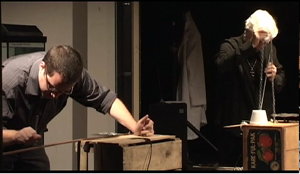 PAULINE OLIVEROS, APPLE BOX THEATRE | "JE POSSÉDAIS UN VIEUX CASIER À POMMES QUE J'AIMAIS ET DONT JE CONNAISSAIS BIEN TOUS LES ASPECTS. C'ÉTAIT COMME UN VIEIL AMI EN FIN DE COMPTE, CAR CE CASIER FAIT EN BOIS SEC ÉTAIT UNE CAISSE DE RÉSONANCE TRÈS EFFICACE. POUR FAIRE RÉSONNER LA CAISSE ET JOUER AVEC, J'AI UTILISÉ PLEIN D'USTENSILES : DES AVERTISSEURS DE TROTTOIR HAUT POUR VOITURES, PETITS OUTILS DE CUISINE, ETC. N'IMPORTE QUOI COMME PETIT OBJET, ET ENSUITE JE LES MANIPULAIS SUR LA CAISSE, J'AMPLIFIAIS LES SONORITÉS OBTENUES. C'EST COMME CELA QUE J'AI RÉALISÉ CETTE PIÈCE SOLO QUI S'APPELLE "APPLE BOX", ET J'AI JOUÉ UNE VERSION EN DUO AVEC DAVID TUDOR "APPLE BOX DOUBLE". EN 1965, J'AI FAIT UNE PERFORMANCE POUR 10 INTERPRÈTES AVEC CETTE PIÈCE DEVENANT AINSI UN "APPLE BOX" ORCHESTRA. C'ÉTAIT ASSEZ ÉTONNANT DE VOIR CES DIX INTERPRÈTES AVEC LEURS "APPLE BOX" ; POUR L'AMPLIFICATION NOUS AVONS UTILISÉ DES AMPLIS À TUBES [...] — L'ENSEMBLE REPRÉSENTAIT EN QUELQUE SORTE 10 CANAUX AUDIO". [27] (Pauline Oliveros, 1999) "J'AVAIS L'HABITUDE D'AMPLIFIER DE PETITS OBJETS [AVEC DES MICROPHONES DE CONTACT] EN JOUANT SUR UN CASIER À POMMES OU SUR LE MUR. J'UTILISAIS AUSSI UNE BAIGNOIRE POUR DES EFFETS DE RÉVERBÉRATION ET DES TUBES EN CARTON COMME FILTRES RÉSONANTS."[28] (Pauline Oliveros, 2003, 2013){/small} |
Alors que Gordon Mumma explorait de son côté la modification électronique des sons acoustiques, Tudor expérimentait la modification acoustique de sons d'origines électroniques, souvent à l'aide d'objets résonants appareillés de petits haut-parleurs/vibreurs qui y étaient physiquement attachés. [...] [29] (Tiré des notes de Gordon Mumma)
Gordon Mumma rapporte qu'à partir de 1970 David Tudor a commencé à travailler sur des sons électroniques enregistrés pour remplacer l'utilisation en direct d'oscillateurs. Ainsi cette nouvelle manière de travailler facilitait la collaboration avec d'autres musiciens (en particulier John Cage) qui n'avaient donc plus besoin de connaître à fond son dispositif technique. Rainforest fût occasionnellement joué en solo lorsque la compagnie Cunningham était réduite en termes de présences de musiciens, et dans ce cas les matériaux sonores et résonants utilisés dans Rainforest étaient simplifiés, ([sans que cela mette en péril le concept et le processus de cette œuvre]), car nous avions remarqué que lorsque nous jouions ensemble chacun de nous laissait toujours de la place et de l'espace dans l'image sonore pour le jeu de l'autre[30].
Dans une description de Rainforest datant de 1968 [mais sans doute rédigée en 1972 selon Matt Rogalsky], David Tudor note quatre possibilités de réalisation :[31]
- en utilisant comme sources seulement des sons générés électroniquement, de toutes sortes ; au moins huit sources sont requises et il est recommandé de faire varier les fréquences utilisées.[32] (Notons au passage que les fréquences sonores les plus simples produisent généralement des résultats complexes[33]). — (Version pour la compagnie de danse Merce Cunningham)
- en utilisant une voix (parlée) comme seule source d'entrée ; les instruments (objets résonants) agissant en tant que filtres. Les sorties peuvent être mixées en stéréo pour cette version. [34] — (Version annonçant Rainforest II)
- idem que 2) mais en utilisant en entrées jusqu'à huit voix, parlées ou chantées, et de quatre à huit sorties indépendantes pour la diffusion.[35] — (Version annonçant également Rainforest II)
- en utilisant des sons enregistrés en entrées. Limiter l'utilisation à deux sons simultanés lors de la performance ; distribuer les sorties sur huit canaux. [36] — (Version annonçant également Rainforest III — Cette quatrième variation décrit ce qui sera utilisé techniquement dans la performance double et simultanée que John Cage et David Tudor ont joué lors de leur tournée en Europe en été 1972. Plusieurs documents dans les archives de Tudor permettent d'identifier cette version comme étant celle de Rainforest III)
À partir de 1969, Rainforest donna lieu à des représentations autonomes (sans la danse de Cunningham) et à des versions successives, d'abord en collaborant avec John Cage avec l'emploi de la voix (Rainforest II et III), puis en se développant en 1973 comme une composition collective et un environnement électroacoustique par l'utilisation de multiples objets comme résonateurs et par l'usage de n'importe quelle source sonore. Tudor note : "any signal input was acceptable, “except composed musics”" (Tout signal d'entrée est acceptable excepté de la musique composée et pré-conçue). De même, nous l'avons vu, l'évolution de version en version (de la I à la IV) est sensible concernant l'envergure et les dimensions utilisées : le nombre de performeurs (un nombre indéfini dans la version IV), et les dimensions et volumes des objets résonants utilisés. En effet, de la version I à la version III, les objets sont de petite dimension (small-scale) pour être transportés dans une ou des valises et ainsi faciliter les déplacements en tournée.
En plus de l'utilisation de principes de filtrage et de mixage, les sons sont redistribués dans tout l'espace de la performance, ce qui conduisit Gordon Mumma a qualifié Rainforest IV de système sonore écologiquement équilibré [par des principes de recyclage]. [37]
Tudor a déclaré dans une interview diffusée en 1988 en Allemagne, ma préférence est d'utiliser des matériaux modulaires qui peuvent changer de version en version. Ceci me permet également d'étendre cette œuvre au fur et à mesure [de manière évolutive] en ajoutant des éléments qui n'étaient pas dans la formation initiale.[38]
Deuxième version, Rainforest II (1968-69)(Edit)
| [...]Pour la seconde version, je voulais utiliser des sources sonores différentes [de celles de Rainforest I], car [dans cette dernière] j'avais pris des oscillateurs qui rendaient des sons ressemblant à des sons animaux et à des chants d'oiseaux. Pour Rainforest II je voulais utiliser une source vocale comme "input" du système amplifié [pour exciter] la résonance naturelle d'un objet. [En fait il s'agissait] d'un "filtre" mécanique [ou de produire l'effet d'un filtre à l'aide d'un tel système].[39] — (David Tudor interviewé par John Fullemann 10/12/85) |
David Tudor déclara après Rainforest I qu'il voulait utiliser dans une seconde version une source vocale comme entrée sonore dans le dispositif[40]. Gordon Mumma rappelle que dans les Cunningham Events (des performances composées de plusieurs extraits collés, assemblés et arrangés ensemble, de chorégraphies existantes de Merce Cunningham et accompagnées par des musiques et des performances musicales improvisées), David Tudor expérimentait déjà sur des traitements sonores des vocalisations et des performances vocales de John Cage[41].
Troisième version, Rainforest III (1972)(Edit)
| Rainforest III consistait à appliquer le principe de n'utiliser aucune source sonore à envoyer dans chaque transducteur. J'ai construit un dispositif spécialement pour la performance simultanée avec John Cage (Mureau). C'était une œuvre de type variable et continuellement changeante, donc j'ai décidé de me baser sur le développement de quelque chose de continu. J'ai donc utilisé des sources sonores enregistrées (sur magnétophone) avec la possibilité de les mixer ou de les séparer pour les utiliser une à une dans différents canaux de sortie.[42] — (David Tudor interviewé par John Fullemann 10/12/85) |
(à traduire) — The “various taped materials” of option 4 were drawn from an extensive sound library which Tudor, Ritty Burchfield and geographer Peter Poole gathered together in 1969 and 1970 for use in EAT’s Pepsi Pavilion at the 1970 World’s Fair in Osaka[43]. From the UK, Poole brought recordings of deer and birdsong. At Jet Propulsion Laboratories, recordings of satellite data communications were gathered. A US Navy laboratory in California provided recordings of neural activity. Some of the first recordings of whale song were also included. Some sounds were recorded by the team including a vivid one of mosquitoes in a jar. The tapes had to be “rescued” when PepsiCo decided they would take over control of their pavilion from EAT. Peter Poole recalls a 3 AM phone call from artist Robert Whitman saying “Gotta get the tapes out!”; they were accosted by a policeman as they threw tapes over the pavilion perimeter. Ritty Burchfield remembers smuggling other tapes out a few at a time, in the pavilion cleaners’ carts.
Tudor made four significant sound pieces for the Pepsi Pavilion, and the library of tapes continued to be an important resource throughout the rest of his career, appearing in numerous compositions and used as source material for Events performances with Merce Cunningham.
According to Tudor’s diagrams for the 1972 version of Rainforest, designed for simultaneous performance with John Cage reading his text Mureau, only four loudspeaker-objects were employed, with input from two stereo cassette decks for four separate tracks of audio source material. Pickups on the objects amplified their resonances into a four- or eight-channel conventional sound system (John Cage did not share Tudor’s system but had his own four-channel loudspeaker setup solely for his live and prerecorded vocalizations). A preparatory list of sound sources per object identifies a selection of laboratory brainwave recordings, water sounds, “vibes” (earth vibrations), and a favourite nightjar recording. A recording of the premiere performance of this version at Radio Bremen has recently been released on New World Records, and in the mix we can aurally identify other Pepsi sounds as well: a beetle walking, a wasp chewing, the mosquitoes buzzing in their jar.[44]
Unfortunately, the New World release of this excellent recording, documenting one of the major (and most pointedly egalitarian) collaborations between Tudor and Cage, has muddied the waters where identification of the various versions of Rainforest is concerned. Tudor’s contribution is (mis-)identified as Rainforest II, and Elliot Schwartz’s liner notes give a mistaken description of the piece, stating that Cage’s vocalizations were used as the primary input to Tudor’s loudspeaker-objects. As far as I have been able to ascertain, from Tudor’s notes and diagrams, and from available recorded evidence, that was never the case on this 1972 European tour. Schwartz’s notes read “warbling sine-wave oscillators are used for Rainforest I ... but, by contrast, Rainforest II is designed for vocal input.” I can agree with this general description, but unfortunately Rainforest II is not the version documented on the CD! (idem)
 | a simultaneous performance by david tudor and john cage of rainforest ii and mureau, recorded live by radio bremen on may 5, 1972 in 1970 cage composed the piece called mureau, in which phrases from thoreau’s journals (in particular, passages which touch on the subject of music) are used as the springboard for an elaborate collage. the resultant fabric combines elements of sense and nonsense, as it veers between contextual meaning and a sort of abstract, linguistic vocalise. in cage’s public readings of mureau, he explored a number of performance variables—differences in tempo, vocal timbre, pitch, register, and dynamics. a similar range will be apparent, in fact, when listening to this recorded performance. this simultaneous performance of mureau and rainforest ii took place in a large concert hall before an audience, rather than privately in a recording studio. whereas in other performance realizations (such as their legendary indeterminacy collaboration) the two men had been placed in separate isolation booths, here the two shared the same performance space, so that each could hear and see the other person’s activity. in fact, cage and tudor sat quite close to one another at the center of the stage, cage performing mureau as a four-channel realization—one live channel against three pre-recorded tracks, all of them his own voice—and tudor actively engaged in real-time processing of cage’s vocal material, using it to generate electronic loudspeaker-filter events. (texte du livret du cd) "John decided that it would be nice to have pieces in which we collaborated in the sense that we did simultaneous performance. Which meant I would compose a piece and he would compose a piece and then they would be performed simultaneously. So we did two such works and they were performed in very large place." — Tudor, David. Interview with Bruce Duffie. Chicago, April 7, 1986. Recording obtained from the interviewer, and transcribed by Matt Rogalsky. http://www.bruceduffie.com/tudor3.html |
Quatrième version, Rainforest IV (1973)(Edit)
| La quatrième version de Rainforest en 1973 est une œuvre environnementale collaborative mixant spatialement des sons en direct de sculptures et d'objets trouvés suspendus avec leurs réflexions transformées au travers d'un dispositif audio.[45] — (David Tudor interviewé par John Fullemann 10/12/85) |
| L'objectif de Rainforest IV était de faire résonner par elles-mêmes des sculptures dans un espace. Une partie de ce travail à faire est en fait de créer un environnement. Les microphones de contact placés sur les objets captent les fréquences de résonance de l'objet même, que l'on peut entendre lorsqu'on se trouve proche de l'objet. Les sons sont ensuite amplifiés par des haut-parleurs [pour rehausser le niveau sonore et donner une autre approche de l'écoute]. [46] — (David Tudor interviewé par John Fullemann 10/12/85) |
| En 1973 j'ai réalisé Rainforest IV, une version dans laquelle les objets au travers desquels les sons étaient transmis étaient de grande dimension et créaient ainsi des présences [distribuées] dans l'espace. C'est-à-dire en fait que leurs résonances étaient perceptibles dans l'espace lorsqu'on s'approchait d'eux à l'endroit où ils étaient suspendus mais aussi dans l'espace tout entier parce que les sons étaient diffusés en supplément sur des haut-parleurs. Le principe est que si vous envoyez du son au travers de ces objets et matériaux, les fréquences de résonance de ceux-ci se trouvent excitées, et ainsi ces résonances peuvent être à nouveau captées par des microphones de contact ou des cellules de lecture d'électrophone. Ces matériaux et objets mis en résonance possèdent chacun une sonorité différente, et leur captation par un microphone de contact rend un son différent que celui que vous entendez lorsque vous êtes près de l'objet suspendu. Cela devient comme des réflexions ou des reflets [acoustiques], et l'ensemble rend, je pense, une atmosphère presque harmonieuse et magnifique, car lorsque vous vous déplacez dans l'espace vous avez l'impression de sortes de réminiscences [ou de rappels et de renvois] de sons que vous avez entendus à un autre endroit de ce même espace [que remplit Rainforest]. C'est en fait une œuvre réalisable par un nombre important de performeurs et d'exécutants ; n'importe quel nombre de personnes peut y participer. [Toutefois] il est vraiment impotant que chacun des performeurs fabrique sa propre "sculpture", décide du système sonore à mettre en place, et performe et joue lui-même son dispositif. Il y a très peu d'instructions et de préconisations qui sont nécessaires à la réalisation de cette œuvre. Je trouve d'ailleurs que c'est une œuvre basée pratiquement sur des formes "d'apprentissage", voire d'auto-apprentissage, du fait que chacun découvre comment il doit programmer et développer son dispositif en fonction de que celui-ci peut "encaisser". Cela a été vraiment une activité très gratifiante pour moi, [qui renvoie beaucoup sur soi-même et sur ce qu'on fait et ce qu'on en fait]. Cette œuvre a été réalisée et jouée par un ensemble assez nombreux de 14 personnes. Donc voici comment Rainforest a été réalisé.[47] — David Tudor interviewé par Teddy Hultberg à Düsseldorf les 17 et 18 mai 1988, http://davidtudor.org/Articles/hultberg.html |
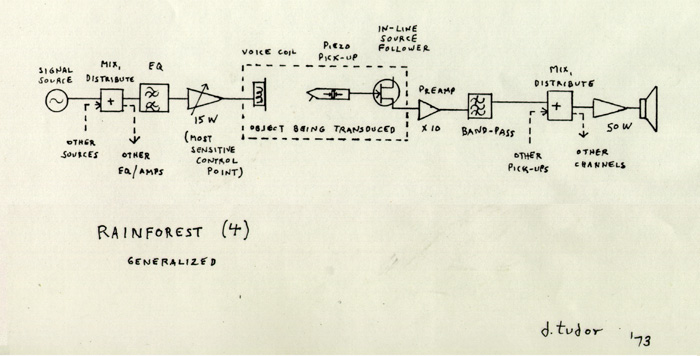 | LA PARTITION/DIAGRAMME DE RAINFOREST IV (SYSTÈME GÉNÉRALISÉ), DAVID TUDOR, 1973 |
(à traduire)
Rainforest is the best known of Tudor’s pieces, in part because the concept is readily understood. One selects an object and the object constrains and shapes all subsequent sonic choices. As one prepares material for the piece, discoveries are made; some sounds “work” for many objects, others do not. To realize the piece, you must collaborate with the object you chose. As a composition, all that must be stipulated are the basic terms of that collaboration, the rest will unfold as ‘nature’. In its initial form, the objects were small and produced small sounds that required amplification. — (Ron Kuivila)
Voici une présentation générale de Rainforest IV rédigée par John Driscoll (du CIE, Composers Inside Electronics) :
(à traduire)
The work is improvisational by nature and typically performed by a minumum of four performers continuously for between 3-6 hours at a time. A minimum of 16 sculptural speakers are used with an upper limit of forty. The work has been installed in approximately 36 different locations (museums, universities, performance centers and even Pierre Cardin’s fashion studio), with over 125 individual performances to date.
The character of a Rainforest IV performance is an informal social environment where visitors are encouraged to wander around and physically interact with the work (including placing your ear against the sculptures, feeling the vibrations in your hand or against your head, and even biting an object allowing the sound to travel through the bones in your head.) Performers are also free to move about during the performance to monitor the sculptural speakers and engage in discussions with the audience. Chairs are placed at the performers’ tables to encourage this interaction. David requested that two particular audiences be invited when possible – the blind and children.
Rainforest IV was technologically a direct outgrowth of the earlier Rainforest versions using low powered amplifiers, electronic and tape source signals and sound transducers fastened to objects.
- La première réalisation de Rainforest IV
(à traduire)
Rainforest IV evolved out of a workshop that David presented at the New Music in New Hampshire Festival (Chocorua, NH) in the summer of 1973. The first performance titled Sliding Pitches in the Rainforest in the Field took place in a large barn and lasted for approximately five hours. The “Sliding Pitches” part of the title came from joint circuit building workshop by Gordon Mumma and David Behrman, and the “in the Field” came from the name of the Inn at which the Festival was held (Stafford’s in the Field). The sculptures included a metal bedspring, a huge wine barrel, toilet floats, cast iron wagon wheel rims, a stainless steel milk container lid, lawn sprinklers, a copper still, styrofoam box, a large metal cable, and more. The performers included: John Driscoll, Phil Edelstein, Linda Fisher, Martin Kalve, Greg Kramer, Susan Palmer, David Tudor, and Bill Viola.
This first realization of the work was probably as much a revelation to David as it was to the other performers for a unique visual and sonic environment was created. This performance set the stage for the evolution of the work over the next 28 years. David stated in interviews that his intention at Chocorua was to “give away” the Rainforest IV work. This desire goes to the heart of a long collaboration which grew into an extended family of associates known as Composers Inside Electronics. — (John Driscoll)
- Les sources sonores
(à traduire)
Questions continually arise about the selection and origin of the sound materials used for Rainforest IV. Each performer is responsible for producing the sound materials for the particular sculptural speakers they construct. These sound materials have covered the gamut from electronically produced to highly amplified natural sounds (ie. a fly walking on paper). The only restriction David ever spoke about is there should not be any pre-recorded musical material used, though at one point in the installation at the Walker Museum, as a spoof, we played the tape that signaled the closing of the gallery through all the sculptures simultaneously.
The source material created is motivated by the unique set of resonant characteristics that each sculptural speaker presents. After investigation, the composer creates material which will tease the resonant nodes into strong vibration creating responses that are highly non-linear. It is the equivalent of tickling someone – a little input at just the right spot creates great output. The resonance nodes of the sculptural speaker contribute to what is heard as much as the original sounds, and in some cases influences the result even more. It is possible to put a sound in which is unrecognizable coming out of the sculpture. For example, David occasionally used two transducers out of phase to create results that did not exist in the source material. — (John Driscoll)
- l'environnement (visuel et sonore)
(à traduire)
A critical aspect of the collaboration is the arrangement of the objects in the performance space creating both a visual and sonic environment. — (John Driscoll)
Forest Speech (1976-79)(Edit)
- Forest Speech: A Live Electronic Environment / Forest Speech: Un Environnement Électronique en direct
Voici l'intitulé et la présentation de David Tudor de cette œuvre qui prolonge Rainforest :
| SYNTHETIC VOICINGS EXPLOSIVE BURSTS. FORMANT RESONANCES, PRODUCED WITH THE NATURAL COMB-FILTERING ACTION OF "RAINFOREST" INSTRUMENTS, ARE USED TO CREATE VOCAL ILLUSIONS. THE ORIGINATING SOUND MATERIALS CAN BE VARIOUS, PROCESSED WITH VOCODER-LIKE CIRCUIT NETWORKS PERFORMED LIVE WITH MULTIPLEXED OUTPUT CIRCUITRY DEVELOPED IN 1976, GROUP VERSION 1978. - DAVID TUDOR[48] | Éclats explosifs de d'émissions sonores synthétiques. Résonances de formants sonores[49], produites par l'action de filtre en peigne des instruments naturels de "Rainforest", sont utilisées pour créer des illusions vocales. Les matériaux sonores originels peuvent être variés et divers, et traités par des combinaisons de filtres et de déphasages similaires à l'action d'un vocodeur[50]. Cette œuvre est jouée en direct sur une matrice de mixage et dérivation des sons pour la diffusion. Développée en 1976, la version pour un ensemble de performeurs date de 1978. - David Tudor[51] |
Rainforest et la référence à la forêt(Edit)
| Gordon Mumma rapporte que pendant que David Tudor travaillait sur le développement de Rainforest, il n'avait pas encore de titre pour cette nouvelle pièce, et quand il a su que la chorégraphie serait intitulée Rainforest, il s'est dit : "Maintenant, il y a un titre". Donc toute rapport entre le titre de l'œuvre et son contenu est apparemment liée à une coïncidence. Toutefois, dans une description ultérieure de David Tudor, il écrit : "La composition a été mise en œuvre à partir de la construction d'instruments spécifiques qui étant manipulés produisent des sons ressemblant à ceux de la nature", et dans un interview datant des années 80, Tudor décrit les sources sonores de Rainforest I comme des oscillateurs qui produisent des sons similaires à des sons animaux et d'oiseaux. Ainsi la relation à un environnement sonore naturel (et imaginaire) existe bien encore dans cette version strictement électronique de Rainforest.[52] (— Tiré de l'article de John Driscoll et Matt Rogalsky, "David Tudor’s Rainforest: An Evolving Exploration of Resonance", issu d'une présentation au symposium “The Art of David Tudor” qui a eu lieu au Getty Research Institute en 2001.) |
Autre référence :
Gordon Mumma parle de "ménagerie électronique" (electronic menagerie) à propos de Rainforest I. — (Gordon Mumma, “From Where the Circus Went,” in Klosty, Merce Cunningham, p. 72)
Au-delà de la référence illustrative (qui pourrait se réduire à une vision de la distribution spatiale des objets résonants dans un espace), il semblerait que la notion d' écoute en forêt soit plus proche d'un objectif de l'œuvre :
- des sons fluctuants, vivants par leur propre organicité ;
- des organisations sonores créant des reliefs, des couches, et qui sont autant de plans possibles que de perspectives (aurales, visuelles) qui se superposent, se succèdent, et qui s'offrent à chaque auditeur ;
- un environnement dans lequel nous sommes totalement en immersion (et non plus face à, comme le suggère de son côté, le terme "paysage"), créant des orientations et des décisions de cheminement de chacun (des auditeurs, des performeurs).
Les réalisations de Rainforest (1968-1996)(Edit)
in progress
Lire la suite - deuxième partie / Continue reading - part2
- ↑"I don’t use any standard instruments" — Tudor, David. Interview with Bruce Duffie. Chicago, April 7, 1986. Recording obtained from the interviewer, and transcribed by Matt Rogalsky. http://www.bruceduffie.com/tudor3.html
- ↑Tudor, David. Interview with Bruce Duffie. Chicago, April 7, 1986. Recording obtained from the interviewer, and transcribed by Matt Rogalsky. http://www.bruceduffie.com/tudor3.html
- ↑"It's important that each person makes their own sculpture, decides how to program it, and performs it themselves. Very little instruction is necessary for the piece. I've found it to be almost self-teaching because you discover how to program the devices by seeing what they like to accept. Its been a very rewarding type of activity for me." — David Tudor, from An Interview with David Tudor by Teddy Hultberg in Dusseldorf, May 17-18, 1988, http://davidtudor.org/Articles/hultberg.html
- ↑Selon les propos de Frances Dyson — Frances Dyson, And then it was now, 9 Evenings, Tudor’s White Noise, Fondation Langlois, 2006 - http://www.fondation-langlois.org/html/e/page.php?NumPage=2152 —, citant Allen Hughes, “Electronics, Not the Piano, Is David Tudor’s Muse Today,” New York Times (Jan. 6, 1977), p. 23. : “the common man [to] become a musician — every man his own musician. It has to happen [...] and electronics is one way it is going to happen.”
- ↑David Tudor and Gordon Mumma have actually combined the roles of musician and engineer by building and performing on their own electronic instruments. — (David Neubert, "Electronic Bowed String Works: Some Observations on Trends and Developments in the Instrumental/Electronic Medium", In Perspectives of New Music, Vol. 21, No. 1/2 (Autumn, 1982 - Summer, 1983), pp. 540-566)
- ↑"“the audio processing and programming, as well as all the software, had to contribute to the oscillating (and unknowable) tendency — including the multiplication of circuits.” — In "9 Evenings: Theatre and Engineering", Pontus Hultén and Frank Königsberg eds. ([New York]: Experiments in Art and Technology; The Foundation for Contemporary Performance Arts, [1966])
- ↑"I found that very simple inputs make the most complex result. If you take a very complex result, it would become very predictable, but if you take something rather simple, than in the end the sound in the output becomes astonishing. It's like a revelation. In order to make those generators I experimented with feedback amplifiers that were capable of unpredictable oscillations The next step for me was obvious because I was searching for a way to generate sound without any input source material. Rather than think of tone generators or recordings of natural sounds etc., I experimented with principles of amplification, trying to make amplifiers oscillate in an absolutely unpredictable manner.
In the and, it turned out that I didn't even need any amplifiers because most electronic equipment uses the principle of amplification. You need filters, modulators and mixing equipment which have gain stages. By piling these components up, I was able to work without any sound generators and I made several pieces in that manner. One of them was "Toneburst" which was also done for Merce Cunningham." — David Tudor, from An Interview with David Tudor by Teddy Hultberg in Dusseldorf, May 17-18, 1988, http://davidtudor.org/Articles/hultberg.html - ↑DT: [...]when the sound appears to be live in the space, then it's free, it seems to flow by itself and not to be caused by some specific intention, especially of an intellectual nature. If you put yourself in a situation of unpredictability and then find that it's completely possible to accept it, then you become an observer. Then you see that the sound can be free. I know it's hard to be clear about that, because a sound is something that you receive, but when you put sounds together, they are in a context and if that is burdened by an intention to conquer or an intention to impress, then...well, if I find myself in that situation, I'm rather unhappy. I smile when the sound is singing through the space.
TH: Do you think that this freeing of the sounds has some social implications?
DT: Yes, I hope so, but you'll never hear me talk about it.
TH: Why not?
DT: I'm not that kind of a composer. — David Tudor, from An Interview with David Tudor by Teddy Hultberg in Dusseldorf, May 17-18, 1988, http://davidtudor.org/Articles/hultberg.html - ↑My piece, "Rainforest IV", was developed from ideas I had as early as 1965. The basic notion, which is a technical one, was the idea that the loudspeaker should have a voice which was unique and not just an instrument of reproduction, but as an instrument unto itself. an offer came, which didn't get realized, but I was asked to make a proposal for a park in Washington. The ideas was to have a sounding outdoor sculpture, so my mind began turning around. I thought, "wouldn't it be wonderful if each sculpture sounded completely different from the other and the whole could be run by one machine which could be like a commutator." — David Tudor, from An Interview with David Tudor by Teddy Hultberg in Dusseldorf, May 17-18, 1988, http://davidtudor.org/Articles/hultberg.html
- ↑"For instance, Rainforest is a piece where the visual element is designed. You take a space and design the way the objects are going to be presented in the space, and the way that the sound is going to permeate the space. So those are design questions." — Tudor, David. Interview with Bruce Duffie. Chicago, April 7, 1986. Recording obtained from the interviewer, and transcribed by Matt Rogalsky. http://www.bruceduffie.com/tudor3.html
- ↑After I got started into electronics and decided to do my own work, the thing that I concentrated on was feedback involving phase shifting. In those days there was no real easy path towards working with that, so I had to do it myself and I researched many different kinds of circuits. [...] In order to get control over phase shift, which is only going to 45 or to 60 degrees—which I was very fond of, the 60 degree point—in order to get control of that you need to restrict the whole thing to a situation where you have great resolution. You may not understand the term, but it’s like you have a dial, you have a volume control on your radio, and if you’ve arrived at full volume when you’ve come to half the point on your control, you don’t have very good resolution. It should go the whole length of the control, and, of course, controls only go so many degrees. So in order to get very precise resolution, you either have to make a situation which is absolutely precise, and you go for limiting it to 60 degrees and nothing else, but for my work it was very useful to have it variable, so I would tend to go for something greater than that, 90 degrees or even 180 degrees, so that I would have some play. So that principle carried me on for years, and many works, one of which came from the other. — Tudor, David. Interview with Bruce Duffie. Chicago, April 7, 1986. Recording obtained from the interviewer, and transcribed by Matt Rogalsky. http://www.bruceduffie.com/tudor3.html
- ↑First version (1968), a sound-score for Merce Cunningham's dance work of the same name, established a means of sound transformations without the use of electronic modulation: the source sounds, when transmitted through the physical materials, will be modified by the resonant nodes of those materials. [...] In the first version, I made objects which I could travel with. The object were so small, however, that they didn't have any sounding presence in the space, so I then amplified the outputs with the use of contact microphones. — (David Tudor, form interview by John Fullemann 10/12/85)
- ↑I eventually acquired some devices called audio transducers. They were first developed for the US Navy because they needed a device which could sound above and under the water simultaneously. I went to see the manufacturer of these devices and they gave me several samples. They later produced a commercial version. I had them in 1968 when MC asked me for a dance score and I decided that I would try to do the sounding sculpture on a very small scale. I took these transducers and attached them to very small objects and then programmed them with signals from sound generators. The sound they produced was then picked up by phono cartridges and then sent to a large speaker system. — David Tudor, from An Interview with David Tudor by Teddy Hultberg in Dusseldorf, May 17-18, 1988, http://davidtudor.org/Articles/hultberg.html
- ↑"Tudor obtained a number of the commercial transducers and they became integrated into his contribution to the 9 Evenings, Bandoneon !, as "instrumental loudspeakers" mounted on four radio-controlled carts which roamed the space during his performance. Sound was directed to twelve conventional loudspeakers in addition to the roving carts, which were used for "spatial variation"." (Matt Rogalsky) —Tiré de l'article de John Driscoll et Matt Rogalsky, "David Tudor’s Rainforest: An Evolving Exploration of Resonance", issu d'une présentation au symposium “The Art of David Tudor” qui a eu lieu au Getty Research Institute en 2001.
- ↑http://www.bruceduffie.com/tudor7.jpg
- ↑ "[...] Merce Cunningham asked me for a piece. Well, I have those things lying around, so I might as well put them to use. So, the first thing I did was to work on an amplifier to run them. I made an eight-channel amplifier with small capacity. And I made objects which I could travel with. And they were so small they didn’t have any sounding presence in the space, so I then amplified the outputs with the use of contact microphones." — Tiré de l'article de John Driscoll et Matt Rogalsky, "David Tudor’s Rainforest: An Evolving Exploration of Resonance", issu d'une présentation au symposium “The Art of David Tudor” qui a eu lieu au Getty Research Institute en 2001.
- ↑"The first version of Rainforest was commissioned by the Merce Cunningham Dance Company in 1968, for an initial fee of $500 plus $25 per performance." — Tiré de l'article de John Driscoll et Matt Rogalsky, "David Tudor’s Rainforest: An Evolving Exploration of Resonance", issu d'une présentation au symposium “The Art of David Tudor” qui a eu lieu au Getty Research Institute en 2001.
- ↑While Cunningham and his dancers evoked the primal movements of fantastic primitive animals, Tudor used oscillators, a homemade eight-channel amplifier, found objects, and contact mikes in order to simulate electronically the sounds of birds and animals in the forest. The circular repeating pulse of Tudor’s manipulated nature sounds and the torn gym suits contributed to the sense of extreme alienation from the body evoked by Cunningham’s Nijinskian-like dancing fauns. — (Levitz, Tamara, "David Tudor’s Corporeal Imagination", Presented at the Getty Research Institute Symposium, “The Art of David Tudor,” in 2001)
- ↑ I was surprised to see how often David just sat aside, not doing anything except perhaps a level adjustment. He would listen carefully, sometimes taking notes (when there was enough light), and then re-enter so that we were working together, or I might “step aside”, in particular when David got lots of sound going. (Gordon Mumma) — Tiré de l'article de John Driscoll et Matt Rogalsky, "David Tudor’s Rainforest: An Evolving Exploration of Resonance", issu d'une présentation au symposium “The Art of David Tudor” qui a eu lieu au Getty Research Institute en 2001.
- ↑http://exhibitions.nypl.org/johncage/node/203
- ↑http://www.serendipite-strategique.com/exemples/slinky.html
- ↑“one didn’t have to think of the generation of electronic music from signal source to the reproducing output, but one, instead, might just as well start from the other end and go back and arrive at a signal source.” — Tiré de l'article de John Driscoll et Matt Rogalsky, "David Tudor’s Rainforest: An Evolving Exploration of Resonance", issu d'une présentation au symposium “The Art of David Tudor” qui a eu lieu au Getty Research Institute en 2001.
- ↑I try to get inside the electronic sound in a way that other people may not. They come from different points of view. A person who’s accustomed to dealing with electronic phenomena and has a modicum of understanding of electronic engineering will attack the whole subject in a way that can be very interesting to me, but I attack the problem differently because I like to find out what electronic equipment can do which is not really programmed into it. — Tudor, David. Interview with Bruce Duffie. Chicago, April 7, 1986. Recording obtained from the interviewer, and transcribed by Matt Rogalsky. http://www.bruceduffie.com/tudor3.html
- ↑Une "apple box'' est une caisse en bois très robuste pour ranger les pommes et fabriqués par les producteurs de fruits. Ce type de boîte est aussi utilisée au cinéma sur les tournages comme accessoire de soutien et de surélévation, http://makingvideo.free.fr/pdf/fabriquez-vos-apple-box.pdf
- ↑An impression of objects functioning and perhaps malfunctioning, if not exactly of human characters climbing over each other up a treacherous slope of drama, is also key to the one utterly improvised piece to be heard on the ONCE box, Pauline Oliveros' and David Tudor's Applebox Double (1965). The title, presumably abstruse, is actually literal. According to Miller, this version of the piece "is an extension of a solo work in which [Oliveros] tapped, struck, scraped, rubbed, banged, and bowed various objects attached to an amplified wooden box. Typical items included springs, metal tongues, "Halloween crickets", and car curb scrapers. For the ONCE presentation, Tudor prepared his own box, hence the name..." (83-84). Although the instruments (which, like Paul Lytton's junkyard drum kits, must have been impressive assemblages) are already open in that they resonate, I would argue that Applebox Double is not about filling a discrete space, but rather, as much as the improvisation is about anything, is occupied with prying, breaching, venting, spilling out. But these boxes do not open easily. Wood jointed and pressed against wood, acoustically nailed and latched "shut", the boxes resist the performer's tools, and so the sounds that unleashed are mostly the sounds of pressure and strain, and of like substances vibrating against one another. Squeaking, creaking, screaming, whimpering, grunting, braying, howling... indeed, the prepared material — the boxes themselves — of Applebox Double almost cannot help but cajole Oliveros and Tudor into the production of noises that are suggestive of the human voice. The sounds of the performers' efforts at opening displace the sounds of what they hope to release. The homology that binds these containers to expandable / contractible "box" — the accordion or squeezebox — with which Oliveros customarily works becomes more and more apparent, as well as more complicated, as the performance proceeds. It is as if there is no escape from the formalism inherent in the mere act of breathing (into a reed, in vowels, across the waters). A kind of tautology is situated at the heart of Applebox Double, a tautology not just of physical realities — lumber, metal, electronics — but also of musical strategies, if you think in terms of what forces are being "unleashed" by these two Pandoras. So, despite the fact that it is very likely the one work here most relevant to a contemporary audience for improvised music, Applebox Double is only intermittently interesting. http://www.bagatellen.com/archives/features/000478.html
- ↑Pauline Oliveros' contribution to this repertory (of live-electronic works with political as well as musical impact [BG]) is a series of apparently self-sustaining works for amplified apple boxes, including Applebox (1964), Applebox Double (1965), Applebox Orchestra (1966), and Applebox Orchestra with Bottle Chorus (1970). p.298, In Jon H. Appleton Dartmouth College . Ronald C. Perera Smith College The Development and Practice of Electronic Music Prentice-Hall, Inc. Englewood Cliffs, New Jersey, copyright 1975. chapter on Live-Electronic Music by Gordon Mumma excerpts Typed by Barb. Golden, Sept 6 1994
- ↑{small} "I had an old apple box I liked and I knew. It was like an old friend as well, because an apple box that has seasoned wood is a very resonant box. I used to amplify the box and put all kinds of things on the box to play: curb scrapers from automobiles, little implements from the kitchen — anything, small little things — and then amplify them, do things with them, make sounds. There was a piece I played as a solo called "Apple Box," and I did a duet with David Tudor called "Apple Box Double." In 1965 I did a performance with ten players, so it was an apple box orchestra. It was an amazing scene, because here were all these ten apple box players, and the amplification was done with tube amplifiers, so all of this stuff had to be hauled out — there were ten channels." (Pauline Oliveros, 1999) — http://www.felbick.de/po5.html (1999)
- ↑"I used to amplify small objects on an apple box or on the wall, and I used the bathtub for reverberation and cardboard tubes as filters. I'd put microphones in the tube and then record sounds through the tube." (Pauline Oliveros, 2003) — http://musicmavericks.publicradio.org/features/interview_oliveros.html (2003) — "I also used a wooden apple box to amplify small objects with a contact mic. That was my processing: an apple box, bathtub and cardboard tubes !" (Pauline Oliveros, 2013) — http://www.csindy.com/coloradosprings/from-john-cage-to-sonic-youth-experimental-music-pioneer-pauline-oliveros-reflects-on-a-life-well-lived/Content?oid=2655997 (2013)
- ↑Traduction du texte de Gordon Mumma présent dans le livret du cd “gordon mumma & david tudor” édité par le label New World (USA) #nw 80651, http://www.newworldrecords.org/album.cgi?rm=view&album_id=16859 http://www.newworldrecords.org/uploads/fileAdomv.pdf
- ↑ “the sounding materials of Rainforest were somewhat simpler, but not dramatically so, because when we performed together we always left room for what the other was doing.”
- ↑— Tiré de l'article de John Driscoll et Matt Rogalsky, "David Tudor’s Rainforest: An Evolving Exploration of Resonance", issu d'une présentation au symposium “The Art of David Tudor” qui a eu lieu au Getty Research Institute en 2001.
- ↑Use only signal generators, any kind, as inputs, At least eight will be required. Vary the waveforms. (Note that simpler waveforms generally produce more complex results).
- ↑"I found that very simple inputs make the most complex result. If you take a very complex result, it would become very predictable, but if you take something rather simple, than in the end the sound in the output becomes astonishing". — David Tudor, from An Interview with David Tudor by Teddy Hultberg in Dusseldorf, May 17-18, 1988, http://davidtudor.org/Articles/hultberg.html
- ↑One (speaking) voice only as input; the instruments acting as filters. The outputs can be mixed down to two for this version.
- ↑As (2.) but with up to eight voices, singing or speaking. Four to eight output channels.
- ↑Various taped materials used as input. Limit these to two at any given time, distributed among the eight channels.
- ↑Traduction librement inspirée et issue du texte de John Holzaepfel présent dans le livret du cd “gordon mumma & david tudor” édité par le label New World (USA) #nw 80651, http://www.newworldrecords.org/album.cgi?rm=view&album_id=16859 http://www.newworldrecords.org/uploads/fileAdomv.pdf
- ↑"My preference is to use modular materials which can change from piece to piece. And also it enables me to expand a piece by adding components to it which were not in the original formation." — Tiré de l'article de John Driscoll et Matt Rogalsky, "David Tudor’s Rainforest: An Evolving Exploration of Resonance", issu d'une présentation au symposium “The Art of David Tudor” qui a eu lieu au Getty Research Institute en 2001.
- ↑In the first version, I made objects which I could travel with. The object were so small, however, that they didn't have any sounding presence in the space, so I then amplified the outputs with the use of contact microphones. Then for the second version, I wanted to have a different kind of input... because for the first I had used oscillators that made animal and bird-like sounds. In the second version I wanted to use a vocal input to the system, the natural resonance of the object and its subsequent amplification. Its a kind of mechanical filter. — (David Tudor, form interview by John Fullemann 10/12/85)
- ↑“In the second version I wanted to use a vocal input to the system.”
- ↑— Tiré de l'article de John Driscoll et Matt Rogalsky, "David Tudor’s Rainforest: An Evolving Exploration of Resonance", issu d'une présentation au symposium “The Art of David Tudor” qui a eu lieu au Getty Research Institute en 2001.
- ↑The third version had to deal with the ability to have any input go to any transducer. I made that system for a simultaneous performance with John Cage (Mureau). It was one of those pieces that changes all the time so I needed to have a sort of continuous thing, so I used tape sources, but having the ability to mix them or separate them into different output channels. — (David Tudor, form interview by John Fullemann 10/12/85)
- ↑"I do re-use [sounds that I have created] because they never sound the same. They never sound the same. For instance, a lot of sound material that I use I collected, or caused to be collected, in 1969-70. I was programming a pavilion at Expo ’70, so I set people to work collecting sounds from biomedical laboratories, both human and animal. A lot of correspondence went on, and from that I got a library of material which I then processed electronically, but only in a primitive way. I didn’t really transform it; I sort of trimmed it to a useful material for me. And I find that I’m still using that, because that’s only an input. It depends on what kind of device is meeting it at the other end. It could sound completely different. So consequently, those tapes that I use, I no longer recognize them. They never sound "au naturel". Never. — Tudor, David. Interview with Bruce Duffie''. Chicago, April 7, 1986. Recording obtained from the interviewer, and transcribed by Matt Rogalsky. http://www.bruceduffie.com/tudor3.html
- ↑— Tiré de l'article de John Driscoll et Matt Rogalsky, "David Tudor’s Rainforest: An Evolving Exploration of Resonance", issu d'une présentation au symposium “The Art of David Tudor” qui a eu lieu au Getty Research Institute en 2001.
- ↑Fourth version (1973): A collaborative environmental work, spatially mixing the live sounds of suspended sculptures and found objects, with their transformed reflections in an audio system. — (David Tudor, form interview by John Fullemann 10/12/85)
- ↑"Rainforest IV"... the object was to make the sculptures sound in the space themselves. Part of that process is that you are actually creating a an environment. The contact mikes on the objects pickup the resonant frequencies which one hears when very close to the object, and then are amplified through a loudspeaker as an enhancement. — (David Tudor, form interview by John Fullemann 10/12/85)
- ↑ In 1973 I made "Rainforest IV" where the objects that the sounds are sent through are very large so that they have their own presence in space. I mean, they actually sound locally in the space where they are hanging as well as being supplemented by a loudspeaker system. The idea is that if you send sound through materials, the resonant nodes of the materials are released and those can be picked up by contact microphones or phono cartridges and those have a different kind of sound than the object does when you listen to it very close where it's hanging. It becomes like a reflection and it makes, I thought, quite a harmonious and beautiful atmosphere, because wherever you move in the room, you have reminiscences of something you have heard at some other point in the space. It's (can be) a large group piece actually, any number of people can participate in it. It's important that each person makes their own sculpture, decides how to program it, and performs it themselves. Very little instruction is necessary for the piece. I've found it to be almost self-teaching because you discover how to program the devices by seeing what they like to accept. Its been a very rewarding type of activity for me. It's been done by as large a group as 14 people. So that was how our Rainforest was done. — David Tudor, from An Interview with David Tudor by Teddy Hultberg in Dusseldorf, May 17-18, 1988, http://davidtudor.org/Articles/hultberg.html
- ↑http://davidtudor.org/Works/forest_speech.html
- ↑On désigne par formant (acoustique) d'un son de parole l'un des maxima d'énergie du spectre sonore de ce son de parole. (Wikipedia)
- ↑Le vocoder ou vocodeur est un dispositif électronique de traitement du signal sonore. Il analyse les principales composantes spectrales de la voix (ou d'un autre son) et fabrique un son synthétique à partir du résultat de cette analyse. (Wikipedia)
- ↑ http://davidtudor.org/Works/forest_speech.html
- ↑"Gordon Mumma recalls that while Tudor was developing the piece, he didn’t have a name for it, and when he heard that the dance was to be called Rainforest, he said “Now there’s a title.” So any connection between the title of the piece and its sonic content is, apparently, coincidental. However, in a later description of Tudor wrote “The composition was implemented thru the construction of special insts. [instruments], which can be manipulated to produce sounds resembling those of nature,” and in an interview in the 1980s Tudor described Rainforest I’s sound sources as “oscillators that made animal-like and bird-like sounds.” Thus connections to a (imaginary) natural soundscape do exist even in this strictly electronic version of Rainforest.
An anecdote from Jean Rigg in March 1970 illuminates these connections – or their boundaries – further. Tudor was not touring with the Cunningham Company; he was in Japan at the time working on the Pepsi Pavilion at Expo 70 in Osaka. Rigg wrote to him:
...we got to the aviary in Pittsburgh, Gordon [Mumma] w/ tape recorder, and John [Cage] ... and I got in to an amusingly heated battle over whether or not Gordon’s aviary recordings belonged in that night’s performance of Rainforest. Well, I don’t know what was amusing about it except maybe to find myself in heated battle with John in the first place. Anyway, it was finally agreed that the recordings were, to use David Behrman’s tactful description, “too literal.”" — Tiré de l'article de John Driscoll et Matt Rogalsky, "David Tudor’s Rainforest: An Evolving Exploration of Resonance", issu d'une présentation au symposium “The Art of David Tudor” qui a eu lieu au Getty Research Institute en 2001.
